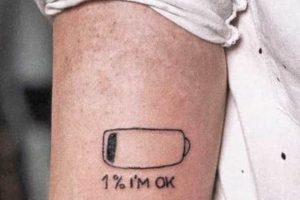Designs incorporating the cross symbol as body art offer a wide range of aesthetic and symbolic possibilities. From simple outlines to intricate Celtic knots interwoven with the classic form, these designs can represent faith, remembrance, sacrifice, or even just artistic appreciation for the shape itself. Examples include minimalist line drawings, ornate crosses adorned with jewels or flowers, or crosses integrated into larger compositions like landscapes or portraits.
The enduring popularity of this imagery stems from the cross’s rich history and powerful symbolism across numerous cultures and religions. For many, it represents a deeply personal connection to their spiritual beliefs, serving as a constant reminder of faith and values. Others may choose such designs to commemorate loved ones, signify personal struggles overcome, or express broader themes of intersection and interconnectedness. The adaptability of the symbol allows for highly personalized expressions of meaning.
Exploring specific stylistic variations, placement options, and the incorporation of complementary elements can further enhance the design’s significance. Considerations such as size, color palette, and accompanying motifs offer opportunities to create truly unique and meaningful body art.
1. Placement
Placement is a critical factor in the overall impact of a cross design. The chosen location affects not only the visibility of the tattoo but also how the design interacts with the body’s natural contours and musculature. Careful consideration of placement ensures the design complements the body and effectively conveys the intended message.
- Forearm
The forearm offers a prominent and relatively flat surface suitable for various sizes and styles. A cross on the forearm can be easily displayed or concealed depending on attire, providing flexibility. This placement is often chosen for designs intended for personal reflection or as a visible reminder of one’s beliefs.
- Chest
The chest, near the heart, carries a strong symbolic weight, making it a popular choice for deeply personal or religious designs. Larger, more intricate designs can be accommodated in this area. The placement over the heart often signifies devotion or remembrance.
- Back
The back provides a large canvas for elaborate designs, allowing for intricate detail and incorporation of additional elements. Large-scale depictions of crucifixions or crosses integrated into larger compositions are often placed on the back. This placement offers the artist significant creative freedom.
- Hand/Fingers
Small, minimalist cross designs are frequently placed on the hand or fingers. These placements are highly visible, acting as a constant visual reminder of the designs significance. They can also symbolize a desire to carry one’s beliefs readily apparent to others.
The chosen placement ultimately contributes to the overall aesthetic and symbolic impact of the tattoo. Considering factors such as visibility, size constraints, and personal preference ensures the final design resonates with the individual’s vision and intent.
2. Style
Style significantly influences the overall aesthetic and symbolic meaning of a cross tattoo. From minimalist linework to elaborate three-dimensional renderings, the chosen style dictates the design’s visual impact and reflects the individual’s personal preferences and beliefs. Understanding various stylistic approaches is crucial for creating a tattoo that resonates with the wearer’s vision.
- Tribal
Tribal cross designs often incorporate bold, black ink and intricate patterns inspired by various indigenous cultures. These designs can represent a connection to heritage or a broader appreciation for the artistic traditions of specific groups. Polynesian, Maori, and Native American influences are common in tribal cross tattoos. The bold lines and patterns create a visually striking and powerful aesthetic.
- Celtic
Celtic crosses, characterized by intricate knotwork and interwoven lines, symbolize interconnectedness, eternity, and spiritual growth. These designs often feature detailed ornamentation and can be rendered in varying levels of complexity. The continuous flow of the knotwork represents the unending cycle of life, death, and rebirth, a core theme in Celtic spirituality.
- Gothic
Gothic cross designs typically feature ornate detailing, dark imagery, and a dramatic aesthetic. Skulls, thorns, and other macabre elements can be incorporated to create a sense of mystery and reverence for mortality. These designs can represent a fascination with the darker aspects of life and spirituality or a connection to Gothic subculture.
- Watercolor
The watercolor style brings a vibrant and fluid aesthetic to cross tattoos. This technique mimics the soft, blended appearance of watercolor paintings, creating a dreamlike and artistic impression. Watercolor cross tattoos often incorporate a range of colors and can be combined with other styles to create a unique and personalized design.
Selecting the appropriate style ensures the cross tattoo effectively conveys the intended message and resonates with the wearer’s personal aesthetic. The interplay of lines, shading, and color within the chosen style contributes significantly to the tattoo’s overall impact and enduring significance.
3. Size
Size plays a crucial role in the design and impact of cross tattoos. The scale of the design must complement the chosen placement on the body and the intricacy of the chosen style. A large, detailed design might overwhelm a smaller area like the wrist, while a minimalist outline might appear lost on a larger canvas like the back. Consider a detailed Celtic cross: a larger size allows for the intricate knotwork to be fully realized, showcasing its artistry. Conversely, a small, simple cross on the finger might symbolize understated faith or serve as a subtle reminder of a loved one. The size also affects the readability of incorporated elements like script or other imagery.
Practical considerations influence size decisions. Smaller tattoos require less time and commitment, often preferred for first-time recipients or those with lower pain tolerance. Larger pieces, however, allow for greater detail and artistic expression but demand multiple sessions and greater aftercare. A large back piece might represent a significant life event or a deep commitment to one’s faith, while a small wrist tattoo could mark a personal milestone or symbolize a quiet devotion. The size should align with the individual’s comfort level and the overall message they wish to convey.
Effectively balancing size with other design elements like placement and style is essential for achieving a visually harmonious and meaningful result. Choosing an appropriate scale ensures the design’s details are neither lost nor overpowering, ultimately maximizing its impact and longevity. Careful consideration of size contributes significantly to a successful and personally resonant tattoo.
4. Symbolism
Symbolism lies at the heart of cross tattoo designs, imbuing them with profound meaning that extends beyond mere aesthetics. The cross itself carries a wealth of historical and cultural significance, making it a potent symbol across various belief systems and personal narratives. Understanding this inherent symbolism is crucial for creating a tattoo that resonates deeply with the wearer and effectively communicates its intended message. For individuals of Christian faith, the cross represents the sacrifice and resurrection of Jesus Christ, embodying themes of redemption, salvation, and eternal life. In other contexts, the cross can symbolize intersection, balance, or the four elements. Its geometric simplicity lends itself to diverse interpretations, allowing individuals to personalize its meaning based on their own experiences and beliefs.
The symbolic meaning can be further enhanced through the incorporation of additional elements. Roses intertwined with a cross might represent love and remembrance, while a skull and crossbones evoke themes of mortality and memento mori. The choice of style also contributes to the overall symbolism. A Celtic cross, with its intricate knotwork, signifies interconnectedness and eternal life, while a tribal cross might represent a connection to ancestral heritage. These design choices allow for a nuanced and layered expression of personal beliefs, values, and experiences. For example, a firefighter might choose a Maltese cross tattoo to symbolize courage, service, and sacrifice, while a cross combined with a loved one’s name and dates serves as a lasting memorial and tribute.
Careful consideration of symbolism ensures the cross tattoo transcends mere decoration and becomes a powerful expression of personal identity and meaning. Understanding the rich history and diverse interpretations associated with the cross allows individuals to select designs that authentically reflect their beliefs and experiences. This imbues the tattoo with enduring significance, transforming it into a visual testament to one’s values, memories, and aspirations. Ignoring the inherent symbolism risks creating a design that lacks depth and personal resonance, diminishing its long-term impact and meaningfulness.
5. Personalization
Personalization elevates cross tattoos from generic symbols to deeply meaningful expressions of individual identity. By incorporating unique elements and tailoring the design to reflect personal experiences, beliefs, and aesthetics, individuals create tattoos that resonate with profound significance. This customization transforms the cross from a widely recognized symbol into a powerful narrative of personal journeys, memories, and aspirations.
- Incorporating Names and Dates
Adding names, initials, or significant dates imbues the cross with personal connections. This can serve as a tribute to loved ones, commemorating their lives and influence. Birthdates, anniversaries, or dates marking pivotal life events can be subtly integrated into the design, adding a layer of personal history and remembrance. For example, intertwining a child’s name with the cross’s arms creates a lasting symbol of parental love and devotion, while incorporating the date of a significant personal achievement signifies resilience and growth.
- Integrating Scriptural Verses or Quotes
Meaningful phrases from religious texts, literature, or even personal mottos can enhance the cross’s symbolic weight. These inscriptions can serve as guiding principles, affirmations of faith, or expressions of deeply held values. Choosing a verse that resonates with personal beliefs adds a spiritual dimension, transforming the tattoo into a constant source of inspiration and strength. A short quote from a favorite poem, for instance, can add a layer of artistic expression and personal reflection.
- Combining with Other Symbolic Imagery
Integrating the cross with other symbolic elements further personalizes its meaning. Flowers, animals, or objects holding personal significance can be incorporated into the design to create a rich tapestry of symbolism. A dove, representing peace and hope, combined with a cross might symbolize spiritual serenity. Similarly, a cross intertwined with a musical instrument could represent a passion for music and its role in the individual’s life.
- Customizing the Cross Design Itself
Modifying the cross’s shape, form, and style allows for further personalization. Deviating from traditional depictions, such as incorporating elements of Celtic knotwork or tribal patterns, creates a visually unique and personally resonant design. Experimenting with color also contributes to personalization. A cross rendered in vibrant hues might represent joy and celebration, while a muted palette could evoke solemnity or reflection.
These personalized elements transform cross tattoos into powerful expressions of individuality, narrating personal stories, beliefs, and experiences through a visually compelling medium. This customization ensures that the tattoo holds enduring meaning, serving as a constant reminder of one’s unique journey and values.
Tips for Choosing a Cross Tattoo
Selecting a cross tattoo design requires careful consideration of various factors to ensure a meaningful and aesthetically pleasing result. These tips provide guidance for navigating the decision-making process, emphasizing the importance of thoughtful planning and collaboration with a skilled tattoo artist.
Tip 1: Research Different Styles: Explore various artistic styles, from traditional to modern interpretations, to identify a style that resonates with personal aesthetics and intended symbolism. Researching different styles ensures the chosen design aligns with individual preferences and desired message.
Tip 2: Consider Placement Carefully: Placement impacts visibility, comfort, and how the design interacts with the body’s contours. Think about how clothing might conceal or reveal the tattoo and how the chosen location complements the design’s shape and size. Different placements carry different symbolic weight and practical implications.
Tip 3: Choose a Reputable Artist: A skilled and experienced tattoo artist can bring a vision to life with precision and artistry. Research portfolios, seek recommendations, and consult with potential artists to ensure their style and expertise align with design goals. A reputable artist understands proper hygiene and sterilization techniques, ensuring a safe and professional experience.
Tip 4: Reflect on Personal Meaning: Infuse the design with personal significance by incorporating elements that reflect individual beliefs, values, or experiences. Consider adding names, dates, or other symbolic imagery to create a truly unique and meaningful piece. Personalization transforms a generic symbol into a powerful expression of identity.
Tip 5: Size Matters: Select a size appropriate for the chosen placement and design complexity. A large, intricate design might overwhelm a smaller area, while a small, simple design could get lost on a larger canvas. Size should complement both the design and the body’s proportions. Larger tattoos require more commitment and aftercare than smaller ones.
Tip 6: Think Long-Term: Tattoos are a permanent form of self-expression. Consider the design’s long-term implications and ensure it remains meaningful and relevant throughout life. Avoid impulsive decisions and take time to reflect on the chosen design before committing. Trends change, but a well-chosen design remains timeless.
Tip 7: Communicate Effectively with the Artist: Clearly articulate design preferences, desired symbolism, and placement to ensure the artist understands the vision. Open communication facilitates a collaborative process, resulting in a tattoo that accurately reflects individual expectations and preferences. Bringing reference images and discussing design details ensures a shared understanding.
By following these tips, individuals can navigate the process of selecting a cross tattoo design with confidence and intentionality. Thoughtful planning and careful consideration of these factors contribute significantly to a successful and personally meaningful outcome.
Ultimately, a well-chosen cross tattoo becomes a powerful statement of personal identity, beliefs, and experiences, serving as a permanent reminder of one’s unique journey and values. The decision to get a tattoo should be approached with thoughtful consideration and respect for the art form.
Frequently Asked Questions
This section addresses common inquiries regarding cross tattoo designs, providing factual information and clarifying potential misconceptions.
Question 1: How much does a cross tattoo typically cost?
Pricing varies based on size, complexity, artist experience, and studio location. Small, simple designs may cost less than larger, more intricate pieces requiring multiple sessions. Consulting with several artists allows for comparison and informed budget planning.
Question 2: How painful is getting a cross tattoo?
Pain levels are subjective and influenced by individual pain tolerance, placement, and tattoo size. Generally, areas with more muscle or fat tissue tend to be less sensitive than areas with thin skin or close proximity to bone. Discussing pain management techniques with the artist can help alleviate discomfort.
Question 3: What are the best placement options for a cross tattoo?
Optimal placement depends on individual preferences, design size, and desired visibility. Popular locations include the forearm, chest, back, and hand. Consider clothing choices and how the design will interact with the body’s contours when selecting placement.
Question 4: How long does it take for a cross tattoo to heal?
Healing time typically ranges from two to four weeks, depending on individual healing rates, tattoo size, and adherence to aftercare instructions. Proper aftercare, including keeping the tattoo clean and moisturized, is crucial for preventing infection and ensuring optimal healing.
Question 5: Can cross tattoos be covered up or removed?
Covering a cross tattoo with another design is possible, but depends on the original tattoo’s size, color, and placement. Laser removal is an option for those wishing to completely remove a tattoo, but requires multiple sessions and may not fully erase the design. Cover-ups and removals are complex procedures requiring experienced artists or technicians.
Question 6: What should one consider when choosing a cross tattoo design?
Careful consideration should be given to style, size, placement, and personal symbolism. Reflecting on personal beliefs, values, and intended message ensures the chosen design resonates with individual identity and remains meaningful over time. Consultation with a reputable tattoo artist facilitates informed decision-making and ensures the final design aligns with personal vision.
Addressing these common concerns promotes informed decision-making and ensures realistic expectations throughout the tattoo selection and execution process. Thorough research and open communication with a skilled artist are crucial for achieving a successful and personally meaningful result.
With a clear understanding of the design process, symbolism, and aftercare requirements, individuals can confidently embark on their tattoo journey, transforming a powerful symbol into a personalized expression of identity and belief.
Conclusion
Exploration of cross tattoo designs reveals a rich tapestry of symbolic meanings and artistic expressions. Careful consideration of placement, style, size, and personalization ensures a deeply resonant and visually compelling result. From minimalist outlines to elaborate depictions, these designs offer powerful avenues for expressing personal beliefs, commemorating loved ones, or simply appreciating the aesthetic form. The enduring popularity of cross tattoos underscores their capacity to convey profound messages and serve as permanent reminders of one’s values and experiences.
Ultimately, a well-chosen cross tattoo transcends mere adornment, becoming a powerful statement of personal identity and a visual testament to one’s unique journey. The decision to acquire such body art should be approached with thoughtful reflection and a deep understanding of the inherent symbolism. Through careful planning and collaboration with a skilled artist, individuals can transform this timeless symbol into a truly personalized and meaningful expression of self.







